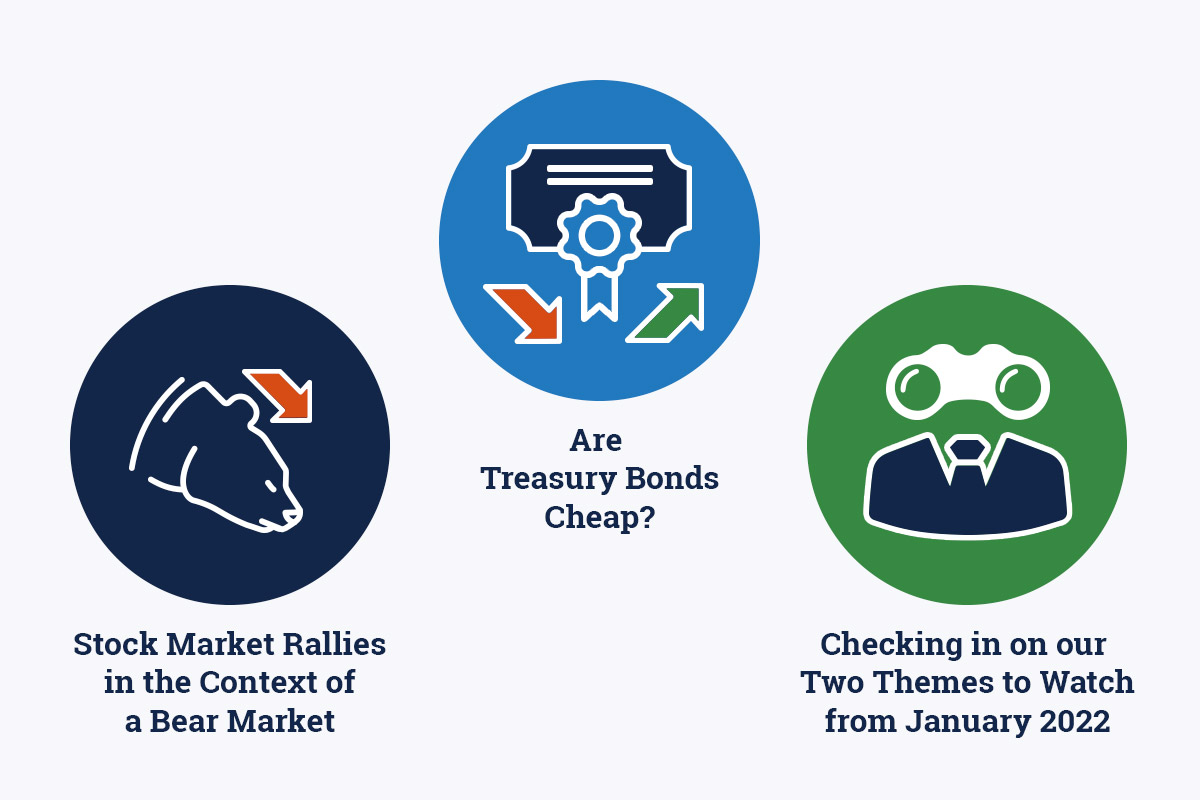
Impact Capital’s quarterly research report seeks to highlight the latest developments most relevant to your investments and financial planning. In this installment of Three Market Themes, we focus on rallies in stocks during a bear market, historically poor bond returns, and look back on a couple of market trends we observed earlier this year.
1. Stock Market Rallies in the Context of a Bear Market

The chart above shows the shifts greater than 5% in the U.S. stock market this year, represented by the S&P 500. Stocks are struggling through a bear market this year, falling by 20%, but what makes bear markets so difficult to navigate is the increase in volatility. Investors have been conditioned to “buy the dip” for years.
The chart shows 11 different rallies of more than 5%. The market went on to make new lows in each of the previous 10 instances. The rally from June to August lasted two months, convincing many investors the bottom was in.
You can imagine how frustrated you would feel if you had been buying the dip successfully for years only to lose money 10 times in a row in 2022 – this is why bear markets are so innately frustrating. Just ask this boat owner:

2. Are Treasury Bonds Cheap?

The chart above shows the yield on the 10-year U.S. Treasury Note from the late 1960s through today. Since bond yields and prices move inversely to one another, the yields are shown using an inverted scale. There have been two dominant trends for bonds during this timeframe — from the late 1960s until 1982, the trend was down for bonds, but since 1982, the trend has shifted upwards.
Since 1982, yields have slipped below the bottom band in 1984, 1987, 1994, and 2000. Each of those years presented investors with an opportunity to make money buying bonds. The chart shows yields are currently at levels last seen in 2008. If the world cannot withstand higher interest rates and the longer-term trend is still moving upwards for bonds, the current moment would present itself as another buying opportunity.
From the late 1960s until 1982, bonds were routinely trending below the bottom band, a reflection of the great downward momentum in bonds and not buying opportunities. Simply put, bonds were a losing proposition. If you view today’s prices in this context, the case could be made that rates are just starting to increase like they did in 1968.
If you don’t want to try predicting the future price of bonds, you can still benefit from higher interest rates. Charles Schwab’s money market, Schwab Value Advantage, is yielding 2.98% right now. If that is better than your bank, transfer it to Charles Schwab. Impact Capital won’t charge a fee on your cash. We just want you to earn the highest interest possible.
3. Checking in on Our “Two Trends to Watch” from January 2022
In our January report — which you can read here — we mentioned two themes to watch in 2022, which have been consistent since 2008:
- Large growth stocks have outperformed large value stocks.
- U.S. stocks have outperformed non-U.S. stocks.
We wondered if 2022 was time for a change.
The chart on the left below shows the performance of large value stocks relative to the performance of large growth stocks. When the line rises, large value stocks are outperforming large growth stocks finally handing large value stocks a victory. Year-to-date through October 23rd, large value stocks have fallen 11.65%. By comparison, large growth stocks have fallen 28.12%.

The chart on the right above below depicts the performance of international stocks relative to the performance of U.S. stocks. When the line rises, international stocks are outperforming U.S. stocks, but international stocks don’t have anything to celebrate.
Year-to-date through October 23rd, international stocks have fallen by 24.6%. By comparison, U.S. stocks have fallen by 20.3%. A stronger U.S. dollar is partially to blame since a rising dollar hurts non-U.S. stock investments, and so investors have therefore flocked to the U.S. dollar as a “safe haven” this year.
However, as the Washington Commanders have been saying for some time: “There’s always next year.”
STAY IN THE LOOP
